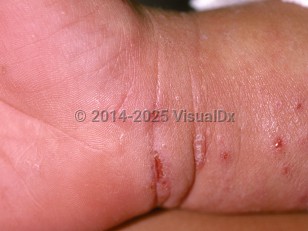Scabies
See also in: AnogenitalAlerts and Notices
Important News & Links
Synopsis

This summary discusses adult patients. Scabies in children is addressed separately.
Scabies is an intensely pruritic eruption on the skin caused by infestation of the mite Sarcoptes scabiei var hominis. It is transmitted most often via direct person-to-person contact and less frequently by fomites. It is extremely contagious, spreading between individuals who share close contact or living spaces. Prevalence rates are higher in children, residents of long-term care facilities, and marginalized populations, although scabies can appear in individuals of all ages and socioeconomic groups.
Scabies is designated as one of the neglected tropical diseases (NTDs) by the World Health Organization (WHO) because of the disease burden and its complications, particularly in areas with limited health care access, and its potential public health control strategies. Factors that contribute to the persistence and spread of scabies are overcrowding, delays in diagnosis, and poor public health awareness. Outbreaks in health care facilities, such as nursing homes, can result in dozens of patients and staff becoming infected.
In a typical infestation, there are 10-20 mites. The mite burrows into the stratum corneum of the epidermis. Most patients mount an intense hypersensitivity reaction to the mites, their eggs, or their feces. This results in a widespread and highly pruritic eruption that can result in disruption of the cutaneous barrier through scratching and superinfection. For those who are acquiring scabies for the first time, the hypersensitivity reaction usually develops 2-6 weeks after initial infestation, but for those with previous history of infestation, the itching may start in 24-72 hours. Without medical treatment, the condition persists because the mites lay eggs, causing continued infestation.
Nodular scabies, a less common variant, refers to the presence of pink-to-red or hyperpigmented nodules that represent a localized, intense hypersensitivity reaction to retained mite parts or antigen. The presence of mites within these nodules has also been reported, but nodular scabies may be seen even after the infestation has been successfully treated. It may involve the genitals. Typical sites also include the lower abdomen and buttocks.
Scabies can cause a generalized eruption resembling erythroderma or exfoliative dermatitis in patients who are elderly, institutionalized individuals, and patients with immunosuppression or neurologic dysfunction (crusted scabies). In these patients, the mite burden is much higher, with thousands to millions of mites present on affected skin.
Scabies is an intensely pruritic eruption on the skin caused by infestation of the mite Sarcoptes scabiei var hominis. It is transmitted most often via direct person-to-person contact and less frequently by fomites. It is extremely contagious, spreading between individuals who share close contact or living spaces. Prevalence rates are higher in children, residents of long-term care facilities, and marginalized populations, although scabies can appear in individuals of all ages and socioeconomic groups.
Scabies is designated as one of the neglected tropical diseases (NTDs) by the World Health Organization (WHO) because of the disease burden and its complications, particularly in areas with limited health care access, and its potential public health control strategies. Factors that contribute to the persistence and spread of scabies are overcrowding, delays in diagnosis, and poor public health awareness. Outbreaks in health care facilities, such as nursing homes, can result in dozens of patients and staff becoming infected.
In a typical infestation, there are 10-20 mites. The mite burrows into the stratum corneum of the epidermis. Most patients mount an intense hypersensitivity reaction to the mites, their eggs, or their feces. This results in a widespread and highly pruritic eruption that can result in disruption of the cutaneous barrier through scratching and superinfection. For those who are acquiring scabies for the first time, the hypersensitivity reaction usually develops 2-6 weeks after initial infestation, but for those with previous history of infestation, the itching may start in 24-72 hours. Without medical treatment, the condition persists because the mites lay eggs, causing continued infestation.
Nodular scabies, a less common variant, refers to the presence of pink-to-red or hyperpigmented nodules that represent a localized, intense hypersensitivity reaction to retained mite parts or antigen. The presence of mites within these nodules has also been reported, but nodular scabies may be seen even after the infestation has been successfully treated. It may involve the genitals. Typical sites also include the lower abdomen and buttocks.
Scabies can cause a generalized eruption resembling erythroderma or exfoliative dermatitis in patients who are elderly, institutionalized individuals, and patients with immunosuppression or neurologic dysfunction (crusted scabies). In these patients, the mite burden is much higher, with thousands to millions of mites present on affected skin.
Codes
ICD10CM:
B86 – Scabies
SNOMEDCT:
128869009 – Infestation caused by Sarcoptes scabiei var hominis
B86 – Scabies
SNOMEDCT:
128869009 – Infestation caused by Sarcoptes scabiei var hominis
Look For
Subscription Required
Diagnostic Pearls
Subscription Required
Differential Diagnosis & Pitfalls

To perform a comparison, select diagnoses from the classic differential
Subscription Required
Best Tests
Subscription Required
Management Pearls
Subscription Required
Therapy
Subscription Required
References
Subscription Required
Last Reviewed:05/15/2024
Last Updated:05/21/2024
Last Updated:05/21/2024
 Patient Information for Scabies
Patient Information for Scabies
Premium Feature
VisualDx Patient Handouts
Available in the Elite package
- Improve treatment compliance
- Reduce after-hours questions
- Increase patient engagement and satisfaction
- Written in clear, easy-to-understand language. No confusing jargon.
- Available in English and Spanish
- Print out or email directly to your patient
Upgrade Today

Scabies
See also in: Anogenital
